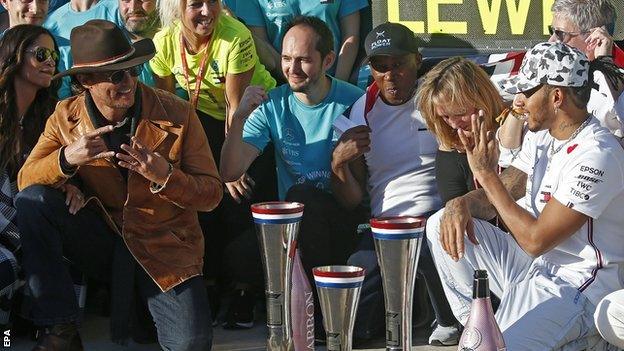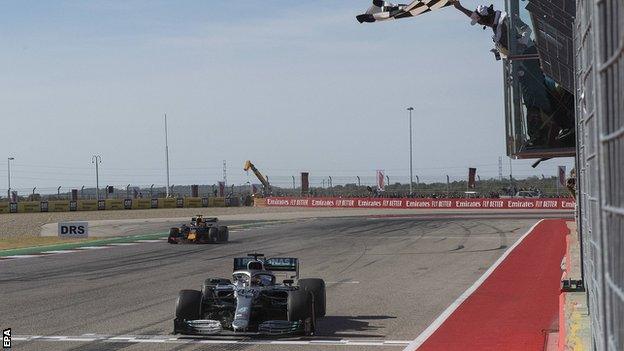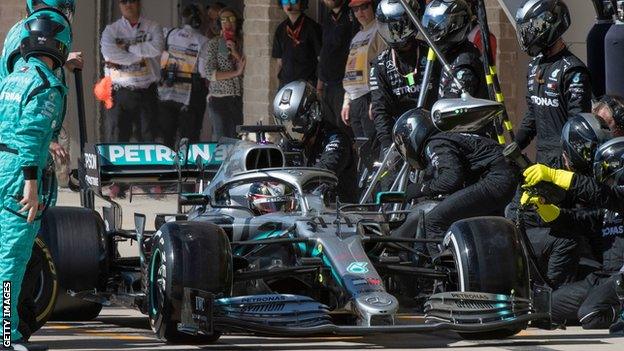Lewis Hamilton's 'most impressive season' in Formula 1
- Published

Hamilton totting up his championships with actor Matthew McConaughey (left)
After clinching his sixth world title, Lewis Hamilton talked in abstract rather than concrete terms about the scale of his achievement.
"I am working on a masterpiece," he said, "and I haven't quite finished it yet. I am trying to understand. It takes a long time to master a craft and while I feel like I am mastering it, there is still more to master, still more to add to it, still more pieces of the puzzle to add.
"There will be more ups and downs along the way, but I feel I have the best tools now to be able to deal with those."
Hamilton's achievement moves him ever closer to becoming the most successful Formula 1 driver of all time, as Michael Schumacher's record of seven world titles is within reach next year.
It comes towards the end of arguably Hamilton's most dominant year, but that in itself raises questions about how to assess where it stands in his career.
Hamilton's 2019 has lacked the stand-out 'wow' moments so often associated with him, such as happened last year with his out-of-nowhere pole lap at Singapore, or his stunning race victory in Italy.
On the other hand, he has been more seamless, more remorseless, more consistent than ever before.
And inside his Mercedes team, they have no doubts about just how high a level Hamilton has reached this season.
Mercedes chief engineer Andrew Shovlin says: "It's perhaps not been his most spectacular season but in many ways it's been his most impressive season. Making mistakes, I can't really think of any things he's done wrong."
Technical director James Allison adds: "He's just been a points machine, getting them wherever. He's won a lot of races.
"[He's been] every bit as strong as last year, just not quite as flashy. It doesn't have that single stand-out appeal of the Singapore lap sort of plucked from nowhere, or the inch-perfect positioning of his car to force Vettel into a mistake in Monza. But go look at his Mexico race if you want to see a professional driver at the peak of his power."
A promise to himself fulfilled

Hamilton bounced back from a poor qualifying session to climb from fifth on the grid at the start of the United States Grand Prix to finish second and seal the title
In the past two weeks, Hamilton has produced two drives emblematic of a year in which the 34-year-old has arguably been more complete than ever before.
There was the victory in Mexico Allison referred to, founded on the controlled way he managed his pace after the team made an early pit stop to jump him into the lead.
And then in Austin on Sunday, he clinched the title with a race that mixed a clinically aggressive first lap, including a stunning overtaking move around the outside of Ferrari's Sebastian Vettel, and then a risky one-stop strategy in an attempt to win from a disadvantageous position that came so close to coming off, as he again managed his tyres with expertise.
But those are just two of a series of top-drawer drives. What has impressed Allison most about Hamilton in 2019 has been "just the metronomic consistency of his race performances all year. He and the car have not clicked in qualifying in quite the way he did with last year's car, but boy oh boy does he make it stick on a Sunday.
"From the beginning of the season, he has been really strong. Despite the fact that Valtteri [Bottas, his team-mate] has had a more consistent and more competitive year, Lewis has built up a very big points advantage by being race after race after race the strongest out there."
The standard view of Hamilton is of a mercurial driver who hits incredible peaks, but also has weekends where, as his former team-mate Jenson Button has said, "you wonder where he'd gone". There have been none of those this year, just a relentless drive towards success.
This change, it transpires, has come of an active choice Hamilton made before the season.
"He said of himself to us that he was determined for 2019 to start the year with the strength he'd finished 2018," Allison says. "That was his promise to himself, that he wasn't going to start weakly and then amaze everyone when he put the pedal down later in the year, because we have all seen that Lewis who switches on like a rocket in the second half of the season, that's happened more than once.
"But he stated at the end of last year that he was going to be operating at his best from the start of this year and that's what he's done."
Hamilton's stand-out races | |
|---|---|
Bahrain | Took the fight to Sebastian Vettel in the faster Ferrari and put himself in the position to inherit victory when Charles Leclerc's engine went sour |
Canada | Pressured Vettel so intensely that the German made an error, went off track, and was given penalty for rejoining dangerously and impeding Hamilton |
France | Adjusted his driving to account for a wind change in qualifying in a way Bottas could not, and destroyed the field in the race |
Silverstone | Kept his tyres in such good shape despite pressuring Bottas hard in the first stint that he was able to run longer and do a one-stop strategy while his team-mate had to do a two |
Hungary | A brilliant fightback victory against Verstappen |
Belgium | Came oh-so-close to catching Leclerc in the faster Ferrari at the end |
Mexico | After a gamble on an early stop to take the lead, managed his pace, and gap to Vettel to win |
Shovlin adds: "You notice it in the conversations with him, where previously the goal for every weekend was stick it on pole and win the race and when that wasn't achievable, that would often lead to over-trying.
"And you notice it in the conversations you have in the office, where he is thinking a bit more of the long game.
"When you look at the good drivers, and certainly the multiple world champions, there is quite a process where they sort of reinvent themselves a bit over the winter and come back stronger.
"It's almost like when you get a new operating system for your phone, and it's not that different, but there are a few bug fixes and a few improvements and stuff, and you don't notice it until you go back three or four versions and you think: 'Wow, that's changed a lot.' And I think that's the case with good drivers and certainly the case with Lewis.
"Every year, he has come back as this more complete driver. There is more that he is capable of. There are areas he starts trying to exploit to find performance.
"The last few years a lot of that has all been out of the car - what he's looking at doing in terms of the work in the factory, and how hard he's developing that area. Also how he's dealing with races that don't go how he'd hoped they would go, how quickly he re-engages and gets back focused on the next race and those are all areas where he has just got better and better and better.
"A lot of people like to have this image of what Lewis was like as a driver, it was all natural ability, not the working hard bit. But he has evolved enormously in his time with us, and he's one of the hardest working drivers I've seen.
"So much has come from when he made a mistake, he was very critical of what he could have done better. But now he puts so much analysis into making sure he doesn't make the same mistake twice and 'how can I avoid mistakes, and where do these situations start to go away from me and start to go wrong?'
"That's something that has led to this championship. He has really had it under control for a long, long time. And I think it's been perhaps the one he has played more than any other as the long game."
The unseen skills

Mercedes chief engineer Andrew Shovlin believes Hamilton's ability to manage his tyres sets him apart from other drivers
In the car, too, the breadth of Hamilton's abilities is often under-recognised. Yes, he's blisteringly fast, but there is an immense subtlety to his technical understanding of the car, and the range of skills he has to adjust to what it needs as it changes in real time.
"One of the key things is you're trying to balance the workload on the front and rear axle," Shovlin says. "So is it a race where we're hurting the front tyres; are we overheating the rears?
"Lewis has a very good feel for which tyres he has to look after. Of the four, it might be one or two he has to look after, and he feels that very early in a stint. He's able to tune the car and how he drives to be able to do that. He thinks about how he's extracting the lap time around the circuit. Which of the corners are going to be hurting those tyres.
"It's something every driver can do; it's just that Lewis can go so much further in terms of really getting that right and being successful. And then you've got mixed conditions and all of those things he deals well with."
Allison gives the example of the first sector of the lap at Barcelona, where the long, high-speed, right-hander of Turn Three punishes the left-front tyre, which therefore becomes the limiting factor in performance, over both a single lap and, especially, a race distance.
"In that first sector there are some left-handers as well," Allison says, "and Lewis will float round the right-handers and then hammer the lefts because the front left is getting hard used, and the front right is under-used.
"So he can smash the front right and know that overall it is going to be OK because the front left is the limiting tyre. And his instinctive ability to feather one and hit the next and then feather the third is really impressive - remarkable."
Another example is how Hamilton manages what is known as 'lift-and-coast', when a driver has to lift off the throttle at the end of the straight before the normal braking point, allow the aerodynamics to slow the car, and then brake later than he would normally do, to save fuel or brakes or both.
Allison refers to the telemetry graphs teams use to analyse performance, which feature lines along an axis that go up and down corresponding to the speed of the car.
"If you imagine, the line would go up to the end of the straight, hit the brakes and there'd be a downward line (as the speed decreases). Instead, he's lifted off and then he'll hit the brakes.
"When Lewis puts the brakes on, he always intercepts perfectly the line he would have been on if he'd carried on full beans to the end of the straight and then hit the brakes. He'll be exactly on that same line, as if he'd never done the lift-off, as if he was perfectly in that same braking moment.
"It's really interesting to be able to hit that every single time exactly the same. And just the delicacy of his right foot. He doesn't break traction unless he wants to, and yet he can make the car fast without spinning up the wheels."

'He will not go quietly into the night'
Ask Allison if there was one moment that stood out for him about Hamilton's season and he does not pick a victory, or a qualifying lap, but something that reveals the intense competitiveness driving the 34-year-old.
"It would be nothing to do with his driving; it would be a character thing," Allison says. "And that was Japan. We won the [constructors'] championship in Japan and for a whole series of reasons we took decisions that were right for the team and a tough pill to swallow for Lewis - securing the championship for the team in a way that was best for the team.
"He swallowed it with good grace. So he didn't throw the dummy out of the pram in public. He didn't make a big scene about it. But the pain it caused him… For every normal mortal, you're looking at a bloke with an enormous lead in the championship, who is going to be champion.
"For Lewis, the pain of finishing one position, maybe two positions, lower than he might have done as a result of other factors caused him a pain that I think would have been no less large than it would have been for the 19-20-year-old Lewis with everything to prove and no points on the table and a hunger to become champion.
"The extent to which that distressed him just shows how much he cares about winning - with all his plaudits, with nothing to prove to anyone in the world, but for himself. He will not go quietly into the night without taking everything that's available when he gets behind the wheel of a car.
"And if you want to understand why Lewis is the champion he is, just look how upset he was at that.
"And by the way not upset with us - he could understand why we did it. Upset just because he could have had more points that race.
"And for a normal, reasonable person, it would have been: 'Ah well, I'll get it done at the next race, or the one after that.'
"But that isn't who he is. He's a champion and it matters to him so much that you can understand why he is as driven as he is - and why I think he will finish his days in a racing car as the most successful driver ever."

